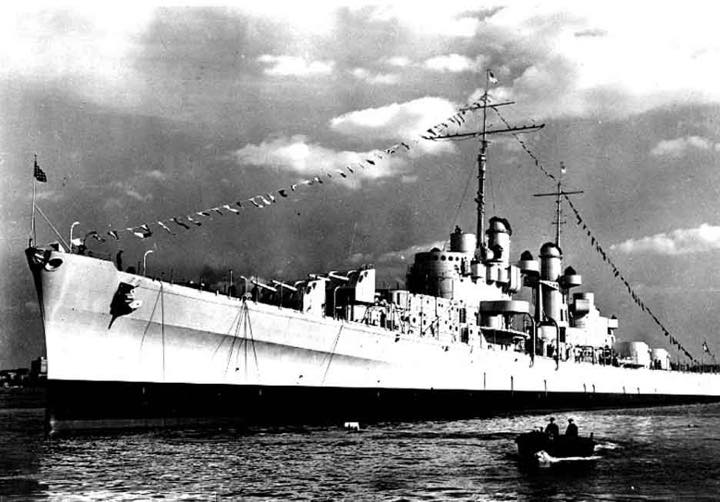Juneau CL-52

Juneau
(CL-52: dp. 6,000; 1. 541'6"; b. 53'2"; dr. 16'4"; s. 32 k.; epl. 623; a. 16 5", 16 1.1", 8 20mm., 6 dcp., 2 dct., cl.Atlanta )
Juneau (CL-52) was laid down by Federal Shipbuilding Co., Kearny, N.J., 27 May 1940; launched 25 October 1941; sponsored by Mrs. Harry I. Lueas, wife of the Mayor of the city of Juneau; and commissioned 14 Februarv 1942, Captain Lyman K. Swenson in command.
Following a hurried shakedown cruise along the Atlantic coast in the spring of 1942, Juneau assumed blockade patrol in early May off Martinique and Guadaloupe Islands to prevent the escape of Vichy French Naval units. She returned to New York to complete alterations and operated in the North Atlantic and Caribbean from 1 June to 12 August on patrol and escort duties. The cruiser departed for the Pacific Theater 22 August.
After stopping brieny at the Tonga Islands and New Caledonia, she rendezvoused 10 September with Task Force 18 under the command of Rear Admiral Leigh Noyes, flying his flag in Wasp (CV-7). The following day Task Force 17, which included Hornet (CV-8), combined with Admiral Noyes' unit to form Task Force 61 whose mission was to ferry fighters to Guadalcanal. On 15 September Wasp took three torpedo hits from the Japanese submarine I-l9, and, with fires raging out of control, was sunk at 2100 by Lansdowne (DD - 86). Juneau and screen destroyers rescued 1,910 survivors of Wasp and returned them to Espiritu Santo, New Hebrides, 16 September. The next day the fast cruiser rejoined Task Force 17. Operating with the Hornet group, she supported three actions that repulsed enemy thrusts at Guadalcanal: the Buin-Fasi-Tonolai Raid; the Battle of Santa Cruz Island; and the Naval Battle of Guadalcanal (Third Savo).
The ship's first major action was the Battle of Santa Cruz Island 26 October. On 24 October lTo7netts task force had combined with the Enterprise (CV-6) group to reform Task Force 61 under the command of Rear Admiral Thomas C. Kinkaid. This force positioned itself north of the Santa Cruz Islands in order to intercept enemy units that might attempt to close Guadalcanal. Meanwhile, on Guadalcanal, the Japanese achieved a temporary breakthrough along Lunga Ridge on the night of 25 October. That short-lived success evidently was a signal for enemy surface units to approach the island.
Early in the morning 26 October, U.S. carrier planes uncovered the enemy force and immediately attacked it, damaging two Japanese earriers, one battleship, and three crulsers. But while our aircraft were locating and engaging the enemy, American ships were also under fire. Shortly after 1000 some 27 enemy aircraft attacked Hornet. Though Juneau and other screen ships threw up an effective AA barrage which splashed about 20 of the attackers,
Hornet was badly damaged and sank the next day. Just before noon Juneau left Tlornet's escort for the beleaguered Enterprise group several miles away. Adding her firepower, Juneau assisted in repulsing four enemy attaeks on this force and splashing 18 Japanese planes.
That evening the American forces retired to the southeast. Although the battle had been costly, it, combined with the Marine victory on Guadaleanal, turned back the attempted Japanese parry in the Solomons. Furthermore the damaging of two Japanese carriers sharply curtailed the air cover available to the enemy in the subsequent Naval Battle of Guadaleanal.
On 8 November Juneau departed Noumea, New Caledonia, as a unit of Task Force 67 under the command of Rear Admiral R. K. Turner to escort reinforcements to Guadaleanal. The force arrived there early morning 12 November, and Juneau took up her station in the protective screen around the transports and cargo vessels. Unloading proceeded unmolested until 1405 when 30 Japanese planes attacked the alerted United States group. The AA flre was devastating, and Juneau alone accounted for six enemy torpedo planes shot down. The few remaining attackers were pounced on by American flghters; only one bomber escaped. Later in the day an American attack group of eruisers and destroyers cleared Guadaleanal on reports that a large enemy surface force was headed for the island. At 0148 on 13 November Rear Admiral D. J. Gallaghan's relatively small Landing Support Group engaged the enemy. The Japanese force of 18 to 20 ships, including 2 battleships, far outnumbered and outgunned his force, but did not outflght it.
American gunnery scored effectively almost immediately sinking an enemy destroyer. Juneau teamed with Atlanta (CL 51) to destroy another as the two forces slugged it out at close range. During the exchange Juneau was struck on the port side by a torpedo causing a severe list and necessitating withdrawal. Before noon 13 November, the battered American force began retirement. Juneau was steaming on one screw, keeping station 800 yards on the starboard quarter of the likewise severely damaged San Francisco (OA-38). ~She was down 12 feet by the bow, but able to maintain 13 knots. A few minutes after 1100 three torpedoes were launched from the Japanese submarine 1-26. Juneau successfully avoided two, but the third struck her at the same point which had been damaged during the surface action. There was a terrific explosion, Juneau broke in two and disappeared in 20 seconds. The gallant ship with Captain Swanson and most of her crew, including the five Sullivan brothers, was lost. Only 10 members of the crew survived the tragedy.
Juneau received four battle stars for World War II service.
 >
>